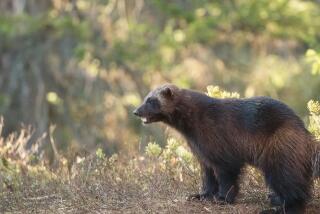At home on the range
- Share via
Since Spanish conquistadors brought horses to the American continent four centuries ago, the majestic animals that once roamed wild on our nation’s great prairies have endured dramatic changes in the American landscape. The grasslands of the Midwest gave way to farms. Barbed-wire fences closed the ranges of Texas. Western cities grew and suburbs sprawled.
Having lost much of their range, wild horses teetered on the verge of disappearing in the 1960s, prompting Congress to pass the Wild Free-Roaming Horses and Burros Act of 1971, which established new federal protections for the animals. Over the last four decades, the Bureau of Land Management has helped wild horses thrive and populations recover on the arid expanses of public lands in the West.
Though an American icon is again flourishing, the job of restoring the health of wild horse herds is far from complete.
Without natural predators, wild horse populations have grown beyond the carrying capacity of the sensitive and sparse lands on which they live, causing damage to ecosystems and putting them at risk of starvation. As a result, federal managers must move thousands of wild horses each year off the range to pastures and corrals, where they are fed, cared for and put up for adoption.
The current situation is unsustainable.
The American people expect the health of their lands and watersheds to be protected, and it is unacceptable to allow wild horses to be malnourished on inadequate ranges. Yet no one wants to see them gathered and moved off Western ranges. Moreover, the status quo comes with a steep price tag. The federal government spends more than $60 million a year on the wild horse and burro program, of which $35 million goes to the care and feeding of the horses.
A broad range of animal rights organizations, conservationists and Western communities agree that we cannot continue down the current path. We must change course.
I agree.
However, if we are to succeed in restoring the health of wild horse herds, we must choose our new path wisely. To allow wild horse herds to grow beyond the limit of the range -- as some wild horse advocates and celebrities are arguing -- is not realistic, humane or environmentally responsible.
Instead, we need a comprehensive and balanced approach built on new partnerships, new thinking and new courage to tackle an issue that, unfortunately, has no easy solution.
First, we must control the growth of wild horse herds by humanely applying fertility control to wild horses on the range. We can do so responsibly and at a reasonable cost.
We must elevate the stature and care of wild horse herds that will sustainably live on Western ranges for generations to come. As Interior secretary, I am examining ways we can better showcase special herds in signature areas of the West to provide eco-tourism opportunities and provide them greater protection.
We must identify and restore new habitat where wild horses could be returned. Some of the prairies and ranges outside the West -- places where forage is rich and where wild horses once wandered -- could become sanctuaries for the animals. I have proposed that through partnerships with the private sector, stakeholders and local communities, we establish new sanctuaries in the Midwest and the East, where healthy horse herds could return.
Finally, we must recognize that the federal government alone cannot restore the health of wild horse herds. We need citizens to help. We want Americans to visit their public lands where horses roam, to help us care for these magnificent animals, to share their ideas with us and to help us find citizens and animal lovers across the country who will adopt wild horses and provide healthy, happy homes for them.
Growing up in Colorado’s San Luis Valley, where my family has farmed and ranched for five generations, I learned that preserving the health of our land and wildlife requires collaboration, patience and courage. Demonizing others in the ways that some advocates have recently demonized federal land managers is neither reasonable nor productive.
We are all seeking to restore the health of America’s wild horse herds and ranges. Let us find common ground and humane, environmentally sound solutions on our public lands.
Ken Salazar is the secretary of the Interior.
More to Read
Sign up for Essential California
The most important California stories and recommendations in your inbox every morning.
You may occasionally receive promotional content from the Los Angeles Times.










